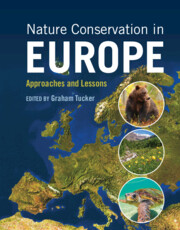Book contents
- Nature Conservation in Europe
- Nature Conservation in Europe
- Copyright page
- Dedication
- Contents
- Contributors
- Preface
- Acknowledgements
- Glossary, Abbreviations and Country Codes
- Chapter 1 Introduction: Aims, Scope, Structure and Key Information Sources
- Chapter 2 Europe’s Nature and Conservation Needs
- Chapter 3 The International Drivers of Nature Conservation, Their Objectives and Impacts on Nature Conservation Policies and Actions in Europe
- Chapter 4 Nature Conservation Policy, Legislation and Funding in the EU
- Chapter 5 Conclusions, Lessons Learnt and Implications for the Future
- Chapter 6 Austria
- Chapter 7 Belgium
- Chapter 8 Republic of Bulgaria
- Chapter 9 Republic of Croatia
- Chapter 10 Cyprus
- Chapter 11 The Czech Republic
- Chapter 12 Denmark
- Chapter 13 Estonia
- Chapter 14 Finland
- Chapter 15 France
- Chapter 16 Germany
- Chapter 17 Greece
- Chapter 18 Hungary
- Chapter 19 Ireland
- Chapter 20 Italy
- Chapter 21 Latvia
- Chapter 22 Lithuania
- Chapter 23 The Netherlands
- Chapter 24 Poland
- Chapter 25 Portugal
- Chapter 26 Romania
- Chapter 27 Slovakia
- Chapter 28 Slovenia
- Chapter 29 Spain
- Chapter 30 Sweden
- Chapter 31 United Kingdom
- Appendix Habitats Directive Annex I Habitat Types Referred to in This Book
- Index
- References
Chapter 3 - The International Drivers of Nature Conservation, Their Objectives and Impacts on Nature Conservation Policies and Actions in Europe
Published online by Cambridge University Press: 11 May 2023
- Nature Conservation in Europe
- Nature Conservation in Europe
- Copyright page
- Dedication
- Contents
- Contributors
- Preface
- Acknowledgements
- Glossary, Abbreviations and Country Codes
- Chapter 1 Introduction: Aims, Scope, Structure and Key Information Sources
- Chapter 2 Europe’s Nature and Conservation Needs
- Chapter 3 The International Drivers of Nature Conservation, Their Objectives and Impacts on Nature Conservation Policies and Actions in Europe
- Chapter 4 Nature Conservation Policy, Legislation and Funding in the EU
- Chapter 5 Conclusions, Lessons Learnt and Implications for the Future
- Chapter 6 Austria
- Chapter 7 Belgium
- Chapter 8 Republic of Bulgaria
- Chapter 9 Republic of Croatia
- Chapter 10 Cyprus
- Chapter 11 The Czech Republic
- Chapter 12 Denmark
- Chapter 13 Estonia
- Chapter 14 Finland
- Chapter 15 France
- Chapter 16 Germany
- Chapter 17 Greece
- Chapter 18 Hungary
- Chapter 19 Ireland
- Chapter 20 Italy
- Chapter 21 Latvia
- Chapter 22 Lithuania
- Chapter 23 The Netherlands
- Chapter 24 Poland
- Chapter 25 Portugal
- Chapter 26 Romania
- Chapter 27 Slovakia
- Chapter 28 Slovenia
- Chapter 29 Spain
- Chapter 30 Sweden
- Chapter 31 United Kingdom
- Appendix Habitats Directive Annex I Habitat Types Referred to in This Book
- Index
- References
Summary
The chapter summarises the main international drivers (other than the EU) of nature conservation in Europe, and their effects on policies and actions, especially within the EU. It starts with a list of key international events that most influenced the evolution of nature conservation, and then provides a tabular summary of the main objectives, obligations and effects of the multilateral environmental agreements (MEAs) and other initiatives that have had a significant impact on nature conservation. Further brief descriptions (with more detail in online Annex I) are given of the Convention on Wetlands (Ramsar Convention), Convention on Migratory Species (Bonn Convention), Convention on the Conservation of European Wildlife and Natural Habitats (Bern Convention), the Convention on Biological Diversity (CBD), a number of Regional Sea Conventions (particularly the OSPAR Convention) and the North Sea Ministerial Conference declarations. The CBD Strategic Plans for 2010 and 2020 are summarised, with a simplified list of targets for 2020 (Aichi targets). A summary is provided of the proposed post-2020 CBD Global Biodiversity Framework (according to plans published as of May 2022).
Keywords
- Type
- Chapter
- Information
- Nature Conservation in EuropeApproaches and Lessons, pp. 41 - 58Publisher: Cambridge University PressPrint publication year: 2023



